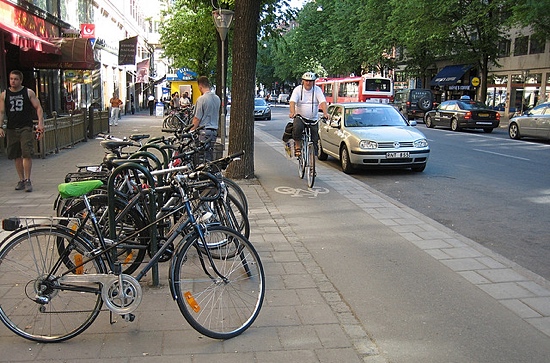City adopts Complete Streets Policy
City Council unanimously voted on a resolution that means the City is now obligated to consider bicyclists and pedestrians in future projects.

Last month, City Council passed a resolution (PDF) putting City officials on the hook to create and implement guidelines that’ll ensure future transportation improvement projects will be planned, designed, and constructed with pedestrians, bicyclists, and transit passengers in mind, in addition to motorists.
Called the Complete Streets Policy, the resolution binds all City departments and employees to follow guidelines that encourage multi-modal transportation options across Richmond. City officials now have one year to create those implementation guidelines, which will be included in the City’s construction standards manual.1
One of the people that pushed Council to adopt the policy is Jakob Helmboldt, the City’s Pedestrian, Bicycle, and Trails Coordinator.
“This is about changing a paradigm,” Helmboldt said by phone last week. Adopting the Complete Streets Policy means the City must now approach every transportation project with eyes on integrating, or improving existing aspects of, every feasible mode of transportation.
“Making sure that we’re looking at each project and each street in that context-sensitive manner and doing the best we can to…make this a city that is great for whatever mode [of transportation] you choose to get around.”
Richmond is the latest city that’s forayed into complete-streets thinking. The National Complete Streets Coalition was founded in 2004 to help bolster transportation networks across the country. Over 650 agencies have adopted Complete Streets policies since.
In 2004, the Virginia Department of Transportation adopted a statewide complete streets policy. “It basically said when you’re scoping a project–whether it’s a maintenance project, a construction project, [or] reconstruction–you will consider the needs of bicyclists and pedestrians,” Helmboldt said.
While a state policy is helpful, Helmboldt said the “rubber meets the road” when individual municipalities get on board. “That’s where you get your bang for the buck in terms of the ability to walk, bike, and use transit as opposed to being reliant on your single occupant vehicle.”
In 2010, the pedestrian, bicycle, and trails commission (appointed by Mayor Jones) submitted a report on how to make Richmond a more bicycle- and pedestrian-friendly city. One of their recommendations2 was that the City adopt its own complete streets policy.
Helmboldt worked with Alicia Zatcoff, the City’s Sustainability Manager, to put the complete streets policy before Council.
Essentially, the policy affects the City more than the general public, at least in that it holds departments and officials accountable to consider transportation in a more holistic sense. “Making sure people are getting training on current best practices or current requirements say, for example, the Americans with Disabilities Act. That can be challenging sometimes, either to understand the regulations or keep up with the changing regulations,” Helmboldt said.
Even seemingly trivial projects stand to benefit. “Giving people [who work at the City] an understanding of how simple projects like signal timing and signal phasing, if you’re doing a maintenance project or a signal upgrade, can have a big impact on the ability to cross the street as a pedestrian, whether you have convenient crossing locations or crossing times,” Helmboldt said.
City Council passing the Complete Street Policy formally declares that the City will consider Richmond roads in a more holistic way. Now Helmboldt and others have one year to create the written guidelines for implementing that encompassing approach.
And while those guidelines still need to be completed, Helmboldt said Richmonders shouldn’t expect dramatic changes in the short term. “I don’t think it would necessarily be really visible in terms of some of the more nuanced things, again because a lot of it is really aimed at good policy and procedure on our end,” he said. “But certainly for someone on the street, I think it’s going to be more noticeable and more reliant biking and walking.”
He said people can expect subtle yet helpful changes, like new pedestrian signals, longer intervals to cross streets, and, for those in wheelchairs, curb ramps compliant with the Americans with Disabilities Act. He hopes people don’t discount little changes. “Little details, a lot of times, add up to a cumulative benefit,” Helmboldt said. “I think it’s one of those things where every now and then you’ll see a big project that’s very visible. But a lot of this stuff will be that cumulative effect.”
He also said the City’s complete streets policy should assist other notable projects, like the Bicycle Master Plan and the Riverfront Plan. Although both plans have complete streets elements already in them, they can easily be overlooked when it comes time to implement those aspects. The Complete Streets Policy “streamlines these things and bakes those into the process so it becomes more of a routine, it becomes a tool to implement those other initiatives that have been laid out as a vision,” Helmboldt said.
With paving projects lined up for this fall and next spring, Helmboldt said people can expect a steady trickle of new bicycle and pedestrian infrastructure. “I think we’re finally on a roll, and I think we’re going to continue to see that pace pick up,” he said.
But as with the complete streets progress, the city’s bicycle and pedestrian friendliness will be a gradual occurrence. “One day you step back and say, ‘Wow. Five years ago, or ten years ago, things were a lot different.’ But you may not necessarily see it day-by-day because it’s incremental,” he said.
Related
Photo of a complete street in Stockholm by EURIST e.V.
- Called the Right-of-Way Design and Construction Standards Manual. ↩
- The commission also recommended hiring a full-time pedestrian, bicycles, and trails coordinator, which led the City to hire Helmboldt. ↩
-
Recommend this
on Facebook -

Report an error
-

Subscribe to our
Weekly Digest





There is 1 reader comment. Read it.